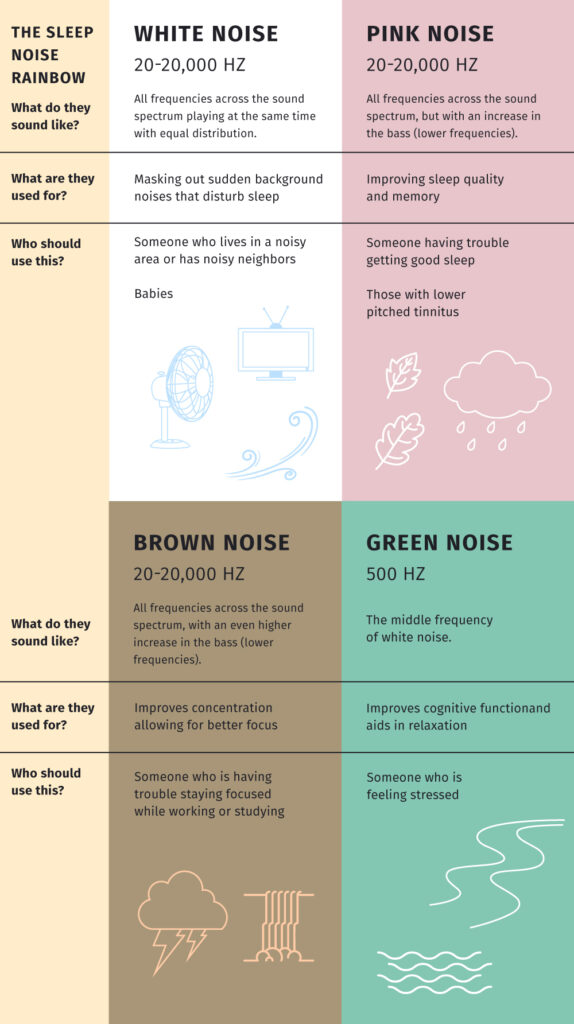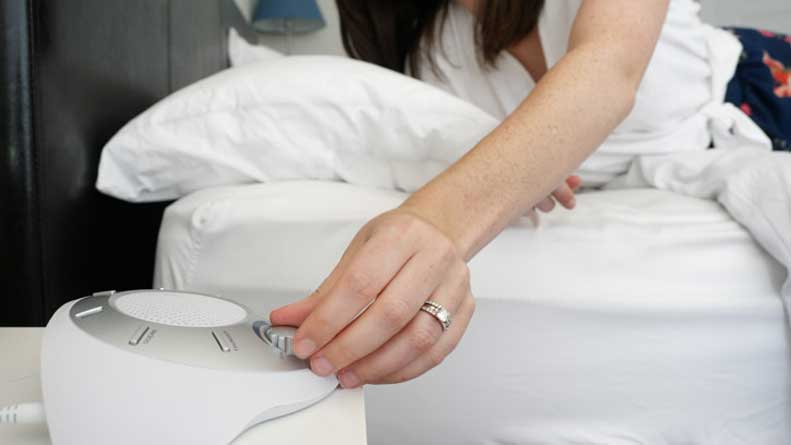Everyone deserves to sleep soundly every night, but you don’t have to let noise stop you from getting a night’s worth of sound sleep. Noise is all around us and is sometimes inescapable, yet certain noises affect sleep favorably and are proven to help people sleep better and longer.
Keep reading to learn how noise and music can benefit your sleep hygiene and what types of noise are best for sleep.
Noise and Sleep Hygiene
Maintaining an ideal noise level in your bedroom is a key aspect of sleep hygiene. Sleep hygiene are the habits that ensure you sleep well, and include creating the perfect sleep environment.
For many people, noise level is one of the most crucial factors in determining sleep quality, along with lighting and temperature. The National Sleep Foundation’s 2018 Bedroom Poll found that 72% of Americans find a quiet room to be an important factor in getting a good night’s sleep. This ranked sixth overall behind factors such as sleeping on a comfortable mattress and a comfortable pillow.
The amount and type of noise in your sleep environment can impact your ability to fall asleep and stay asleep. Sound has the power to trigger psychological and physical effects ranging from increased stress and heart rate to improving mood and lowering blood pressure. Although some noises are beyond your control, managing the noises you can control can have profound effects on your sleep quality and overall well-being.
What is a Healthy Noise Level for Sleep?
Exposure to loud noises has short- and long-term health effects including hearing damage. Although some white noise machines and other devices can produce sound up to 85 decibels, we don’t recommend maintaining noise levels over 70 decibels while sleeping. The sound of a vacuum cleaner or running dishwasher is around 70 decibels, while a lawn mower is around 85 decibels. Several free apps are available to check your room’s decibel level to measure how loud environmental noise sounds inside your bedroom.
Some people are more susceptible to noise disturbances than others. If you live in an urban area or a less insulated home, you are most likely to experience loud noises throughout the night compared to those living in residential areas. Children and seniors are also more sensitive to noise and the risks associated with noise-related sleep disturbances. The American Academy of Pediatrics recommends not exceeding noise levels of 50 decibels on white noise machines for babies and small children.
Sleeping with Noise vs Sleeping in Silence
The amount of noise you sleep with, if any, is up to personal preference. There is not a clear consensus on the best noise to sleep with and noise preferences for sleep widely vary. In The State of Sleep in America 2022 Report by Casper and Gallup, 12% of adults use a noise machine as a sleep aid. An additional 21% of adults use an air conditioner or open window as a sleep aid which impacts noise level and regulates temperature.
Let’s go over some of the pros and cons of sleeping with healthy noise, music and silence. I’ll also address the risks of noisy sleep environments.
Benefits of Noise for Sleep
Noise is not an inherently bad thing for sleep. When utilized correctly, sleep noises can make your sleep environment feel more comfortable and improve your sleep quality. Typically, voluntary noises playing in your bedroom are used to mask annoying environmental sounds, and they can also distract from thoughts from the day keeping you awake. Later, I will be touching on the best noises for sleep including white noise and pink noise.
Benefits of Music for Sleep
If sleep noises aren’t your thing, music can also help relax you and distract yourself from unwanted noise and inner thoughts. Music is a widely used sleep aid that is a part of many people’s sleep routines. Listening to music while you are getting ready for bed can act as a cue for your brain to calm down, making it easier to fall asleep.
Along with the benefits of improving your sleep routine, music has mental and physical benefits for sleep. Several studies have displayed the advantages of music for common sleep complaints such as high sleep latency, taking a long time to fall asleep, and insomnia. Relaxing music reduces stress hormone levels to help calm racing thoughts and clear the mind.
A 2018 study found that younger respondents reported higher levels of engagement with music, and they were more likely to use music as a sleep aid.
Keep in mind, not all music is beneficial for sleep. The general traits to look for are having no lyrics and a beats per minute (BPM) between 40-80. Lyrics tend to be too mentally stimulating to properly relax your mind for sleep. Relaxing music with low BPMs has the ability to reduce heart rate to a good resting heart rate for sleep around 40 to 60 BPM.
Take a look at this free music playlist that’s designed to help you fall asleep at night.
Benefits of Silence for Sleep
For some, environmental noise is not a major sleep disturbance. A near silent environment is widely believed to be the best possible noise level for restful sleep. Benefits of sleeping in silence are much more straightforward than the benefits of listening to noise. It is easier to practice mindfulness and calm racing thoughts in still, silent environments compared to unpredictable environments with changing noise levels.
Although there are no risks to sleeping in silence, it definitely is not for everyone, such as the light sleepers out there. Sometimes listening to absolute silence can feel as uncomfortable as trying to fall asleep through irritable noises. If you are experiencing difficulty falling asleep in silent environments, experiment with sleeping with low volume noise or calming music.
Risks of Environmental Noise for Sleep
Loud environmental noise can be harmful to sleep if not dealt with. These noises can make it more difficult to fall asleep and keep you from sleeping a full eight hours which can negatively impact daily functions. Sleep disruptions from environmental noise have been shown to worsen memory and cognitive function in adolescents.
Unwanted or disturbing noise that interferes with sleep or daily functions is also known as noise pollution. Noise pollution is more than an inconvenience, it’s an environmental concern. Sounds from traffic, businesses and events above 65 decibels have short- and long-term negative consequences on wildlife and communities.
Being exposed to noise pollution at night could cause poor cognitive function, irritability and sleepiness the next day. Long-term sleep disturbances and poor sleep quality have been linked to higher risk of high blood pressure, hypertension, obesity and more.
Types of Noises to Sleep to
There is no one best sound to listen to when trying to sleep. The best noise to incorporate into your sleep environment is whatever helps you relax and puts you to rest. This can range from listening to guided meditations, ASMR or gentle sounds from nature.
Types of noises for sleep are categorized by color which is in reference to their frequency range. Read more about the four colors of noise associated with sleep below to find out which one is best for you.

White Noise
White noise is possibly the most popular noise color people associate with sleep. Many describe it as sounding like TV static or the humming sounds from a fan or vacuum cleaner. What makes white noise effective is that it masks sounds in all frequencies humans can hear. It plays these frequencies at the same intensity, making it the best noise to sleep to if you need to drown out disruptive sounds.
One thing to point out is that studies have shown inconclusive results on whether or not white noise benefits sleep quality. For some, white noise can be too stimulating to fall asleep to because of its equally intense frequencies. So give white noise a try using YouTube or a sleep app before buying a white noise machine.
Brown Noise
While brown noise also comprises all audible frequencies, its deeper sound comes from its more intense lower frequencies to bring people to a relaxed state. It is usually compared to the low rumbling noises of thunderstorms or a humming plane engine.
This effect results in the listener’s thoughts being drowned out by noise and allowing their brain to be “turned off” for restful sleep. Brown noise is also known to be effective for strengthening focus, particularly for those with ADHD, although more research is required to understand this phenomenon.
Pink Noise
Pink noise is similar to white noise, but utilizes lower frequencies at higher intensities. However, these lower frequencies are not as low as brown noise, resulting in a pitch that’s deeper than white noise but not as deep as brown noise. Of the three broadband sounds, pink noise is found most frequently in nature. It is often compared to ocean waves, rustling leaves and gentle rainfall.
One study found that playing pink noise synchronized brain waves to a low level leading to subjects experiencing more stable sleep time with fewer disturbances. Pink noise especially improves the deep stage of sleep that is associated with energy restoration and memory retention. These are just some of the reasons why people consider pink noise to be the best noise for improving sleep quality.
Green Noise
Green noise is a type of noise that is associated with sounds of nature and is described as being more gentle than white noise. Think about the sound of crashing waves and waterfalls to get an idea of what green noise is like. Unlike other popular sleep sounds, it is only made up of mid-range sound frequencies at an equal intensity.
Because green noise is a newer phenomenon, there are fewer scientific studies on its effects on sleep compared to white or pink noise. Nevertheless, it is said to have a calming effect that can drown out other noises or reduce stress.
Types of Sleep Noise Devices
Noise can improve your sleep hygiene when utilized properly. If you are someone who prefers to sleep with noise, there are different types of devices and tools on the market for just the thing.
Noise Machines
Noise machines are a popular way to healthily incorporate noise into your sleep environment. The most common noises on these machines are white noise, fan noises and nature sounds like thunderstorms or crashing waves. Noise machines should be used with some caution to prevent possible hearing damage or sleep disturbances. For the best sleep hygiene, set sleep timers on noise machines and ensure they play at a healthy noise level.

Sleep Headphones
Sleep headphones are the ideal noise device when your partner prefers to sleep in silence. Unlike normal headphones, sleep headphones are typically constructed as a flexible headband with small speakers near the ears. Some models even double as eye masks to block out unwanted light. It’s not recommended to wear normal headphones/earbuds for sleeping to prevent earwax build-up or have wires wrap around you.
Sleep Apps
Several apps are designed to provide users with calming noises and music that are ideal for sleep. Sound sleep apps include personalized settings combined with hundreds of noise tracks to offer something for everyone. YouTube and Spotify also feature sleep noise and music playlists uploaded by users as a completely free alternative to sleep apps. Keep your phone at a distance from your bed and limit the amount of light emitted to practice healthy sleep hygiene.
Fans and Air Purifiers
Running fans or air purifiers in your bedroom is another way to add white noise in your bedroom. On average, fans and air purifiers produce noise levels between 40 and 60 decibels. This is about as loud as an office space or a conversation at a normal speaking level. Other bonuses of running a fan or air purifier is that these devices circulate air, regulate temperature and reduce allergens in the air to promote healthy sleep hygiene.
How to Sleep Through Loud Noises
Sometimes you can’t control the loud noises around you when you’re trying to sleep. Luckily, we have a few methods to help you stay asleep even around loud noises.
Minimize Noise Around Your House
Scan around your home for any possible home devices, systems or furniture that could be making noise at night. Be sure to turn off household appliances and only run laundry and dish cycles during the day. Using lubricants like WD-40, securing loose screws and nails and applying felt pads on furniture legs can all minimize noise in your bedroom if you don’t have a carpet or rug. If you’re unable to identify the sources of irritable noises around your home, consult a contractor to help alleviate the problem.
Mask Unwanted Noises
Another way to combat loud noises is by using other sounds to drown them out. Devices like white noise machines can help overpower noises coming from inside and outside your home. Playing music from a phone or speaker at a low to medium volume can also serve as a distraction from bothersome noises. Be sure to only play counteracting noises or music at a low volume and keep the device at least six feet away from your bed, if possible.
Soundproof Your Room
Often, reducing noise is as easy as making small changes to your room. Look for soft surfaces and bulky furniture like bookcases to cover solid surfaces which reverberate noise. Wall decor such as tapestries and acoustic paneling are all effective at absorbing noise. Lastly, thick curtains are the best, easiest way to block out noise from outside your home.
Train Your Mind
If nothing else works, it’s possible to train your brain to sleep through noise by using meditation techniques. Focusing on your breathing and mindfulness can take your attention from unwanted noise while also relaxing your mind. Admittedly, meditating in a noisy environment is a difficult task, especially for beginner meditators. But over time, it will become easier to become accustomed to low-volume traffic and wildlife noises.
FAQs
Can noise affect your quality of sleep?
Noise can positively or negatively affect sleep quality depending on the type of noise around you and its volume. Loud and irritable noises can disturb sleep and could lead to short- and long-term health effects. But sound and music can also be used to create a healthy sleep environment and help people sleep better.
What color noise is best for sleep?
Different color noises target different common sleep complaints. White noise is the best noise to mask environmental noises that would otherwise keep you awake. Pink noise is the best noise to calm your mind and improve sleep quality. Brown noise is the best noise for clearing your mind and masking mental distractions. Other noises like green noise are also beneficial for relaxation and sleep.
Is it okay to listen to music while you sleep?
It’s perfectly okay and even beneficial to listen to music while you sleep. Instrumental music with low beats per minute (BPM) is ideal for relaxation and easing you to sleep. Fast-paced or lyrical songs are typically too mentally stimulating.
Is it better to sleep with noise or no noise?
The best noise level to sleep with is whatever is easiest to fall asleep to. Some people prefer to sleep in silence because it’s easier to focus on mindfulness and breathing. Others prefer to sleep with low volume noise or music to distract from environmental noise or help them relax.
Does noise affect deep sleep?
Environmental noise is more likely to affect the lighter stages of sleep than deep sleep or REM sleep. Being disrupted in the middle of the night during a lighter stage of sleep will decrease the amount of time spent in deep sleep.

